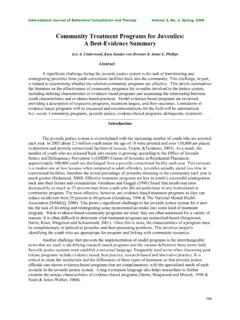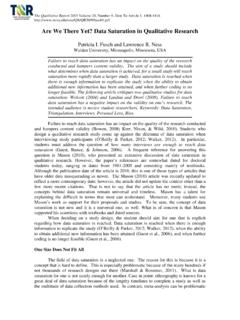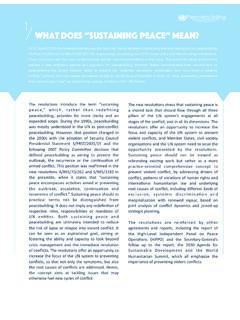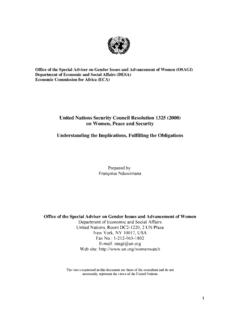Transcription of A chitosan coated monolith for nucleic acid capture in a ...
1 A chitosan coated monolith for nucleic acid capture in athermoplastic microfluidic chipEric L. Kendall,1 Erik Wienhold,2and Don L. DeVoe1,a)1 Department of Mechanical Engineering, University of Maryland, College Park, Maryland20742, USA2 Department of Materials Science and Engineering, University of Maryland, College Park,Maryland 20742, USA(Received 6 May 2014; accepted 14 July 2014; published online 21 July 2014)A technique for microfluidic, pH modulated DNA capture and purification usingchitosan functionalized glycidyl methacrylate monoliths is presented. Highlyporous polymer monoliths are formed and subsequently functionalized off-chip ina batch process before insertion into thermoplastic microchannels prior to solventbonding, simplifying the overall fabrication process by eliminating the need for on-chip surface modifications. The monolith anchoring method allows for the use oflarge cross-section monoliths enabling high flowrates and high DNA capturecapacity with a minimum of added design complexity.
2 Using monolith capture ele-ments requiring less than 1 mm2of chip surface area, loading levels above 100 ngare demonstrated, with DNA capture and elution efficiency of AIP Publishing LLC.[ ]INTRODUCTIONN ucleic acid capture and purification are often a necessary step prior to PCR amplificationduring genetic analysis to isolate the nucleic acids from other components of biological samplematrices such as cell lysate and blood plasma which could otherwise introduce components thatinhibit PCR replication of target DNA sequences, degrading efficiency of the amplification pro-cess and resulting in poor assay , modern laboratory scale DNA purification is achieved by silica-based solidphase extraction (SPE) where cell lysate is exposed to a silica surface in the presence of chaot-ropic strategy has been employed in a variety of microfluidic formats usingpacked beds of silica beads3and polymer monoliths with embedded silica particles4 6as thesolid phase.
3 The extraction efficiency of SPE methods is high (68% 80%); however, the chaot-ropic agents can be potent PCR inhibitors, thereby requiring copious washing to ensure that aninhibitor-free DNA solution is eluted as a final aqueous and PCR compatible alternate approach to chaotropic SPE is electrostaticallydriven, pH modulated nucleic acid capture on an amine-rich surface which can be controllablyswitched between cationic and neutral states. Such charge switching methods have been imple-mented in microfluidic systems, with various aminosilanes used to coat glass microchannels toyield a capture substrate with pH switchable surface an effective alternative to aminosilanes, the aminosaccharide biopolymer chitosan hasalso been employed as a pH modulated surface treatment for nucleic acid capture in microflui-dic 10 While high loading levels and extraction efficiencies have been reported usingchitosan as a charge-switching polymer for microfluidic DNA capture and release, reportedmethods typically require long channels distributed over large device areas to achieve this per-formance.
4 This constraint is imposed by the need for sufficient surface area to achieve accepta-ble loading capacity. While high aspect ratio microstructures can be used to enhance AIP Publishing LLC8, 044109-1 BIOMICROFLUIDICS8, 044109 (2014) This article is copyrighted as indicated in the article. Reuse of AIP content is subject to the terms at: Downloaded to On: Mon, 21 Jul 2014 14:24:32area, this approach requires the application of complex fabrication methods that are undesirablefor use in disposable sample preparation chips. Furthermore, long or wide channels are requiredso that the residence time during perfusion through the capture zone is significantly longer thanthe characteristic diffusion time for each sample component, ensuring sufficient interactionsbetween DNA and the channel walls to promote efficient , we present a simple approach to microfluidic, pH-modulated nucleic acid capture in the formof a chitosan -functionalized porous polymer monolith .
5 While monoliths have been used previously invarious implementations of microfluidic silica-based SPE,4 6the use of porous polymer monolith sup-ports has not been previously explored for chitosan -enabled nucleic acid capture based on efficientcharge switching. By employing monolith elements with high surface area and small pore size as chito-san supports, highly effective DNA capture with exceptionally high loading limits is achieved in a smallon-chip footprint. The tortuous pore network inherent to the polymer monoliths also enables rapidrelease during the elution step. In addition to demonstrating the benefits of porous monoliths as high sur-face area substrates for efficient DNA capture , we further leverage a unique off-chip process that enablesparallel batch scale preparation of chitosan -bearing monoliths, followed by integration of the pre-functionalized monolith elements into the disposable thermoplastic microfluidic devices.
6 This processprovides a scalable and low cost option for integrating nucleic acid capture , concentration, and releasefunctionality to a range of microfluidic analytical platforms fabricated in thermoplastics. Using thisapproach, DNA loading levels above 100 ng are achieved using 1 mm long monolith capture elements,while repeatable recovery above 50% of the total loaded DNA sample is AND METHODSG lycidyl methacrylate (GMA), cyclohexanol, methanol, ethanol, 2,2-dimethoxy-2-phenyla-cetophenone (DMPA), sodium phosphate dibasic, N-[c-maleimidobutyryloxy]succinimide ester(GMBS), and decahydronaphthalene (decalin) were purchased from Sigma Aldrich (St. Louis,MO). Ethoxylated trimethylolpropane triacrylate (SR454) was received as a free sample fromSartomer (Warrington, PA). Cyclic olefin copolymer (COC; grade 1020R) was purchased fromZeon Chemicals (Louisville, KY). PUC 19 plasmid DNA was purchased from Fisher Scientific(Pittsburgh, PA).
7 monolith preparationGMA monolith elements were produced off chip and integrated into COC microchannelsaccording to a previously reported , a solution consisting of GMA, , Cyclohexanol, methanol, and DMPA was injected into a COC micro-channel mold with a trapezoidal cross section and the access holes were sealed with tape. The COCmold was cut with a conical endmill to a depth of 640lm. Photopolymerization was achieved withusing a UV light source (Sun Ray 400 SM UV Flood Lamp) outputting 39 mW/cm2for 600 chitosan functionalization of GMA monolith was achieved by soaking newlyformed, washed monolith elements in a 1% solution of chitosan in water. Temperature was con-trolled over long reaction times by placing a vial of the monoliths and solution in an bifunctional cross-linker GMBS was also used to attach chitosan to the GMA mono-liths using an adaptation of a previously reported antibody anchoring fabrication and bondingMicrochannels and access holes were directly milled in a 2 mm thick COC plaque using aRoland MDX650 CNC milling machine.
8 monolith receiving channels were patterned with thesame end mill used for the mold, but milled to a depth of 580lm to account for monolithshrinkage. Chip bonding was accomplished by first exposing both top and bottom portions ofthe chip to 25% (vol. %) decalin in ethanol for 10 min, then rinsing each thoroughly in ethanoland drying with nitrogen prior to monolith insertion. Functionalized monoliths were manipu-lated into position in the open channel with a wet fine-tipped paint brush before the two halveof the chip were mated together. The assembled chip was then pressed at 300 psi in a hot press044109-2 Kendall, Wienhold, and DeVoeBiomicrofluidics8, 044109 (2014) This article is copyrighted as indicated in the article. Reuse of AIP content is subject to the terms at: Downloaded to On: Mon, 21 Jul 2014 14:24:32at 60 C for 10 min and released without cooling. Cryo-fracturing of chips for SEM imaging ofthe sealed monoliths was performed by making superficial cuts with a band-saw along thedesired line of fracture, submersing the chip into liquid nitrogen, and cleaving the chip alongthe initial capture and release experimentsControl solutions of DNA in loading buffer (50 mM MES pH 5) and elution buffer (10 mMTris, 50 mM KCl, pH 10) were prepared by serial dilution.
9 Prior to DNA loading, chitosancoated monolith chips were flushed with approximately 50ll of the loading buffer. A solutionof DNA in loading buffer was pumped through the monolith chip using a syringe pump,Hamilton gastight glass syringes, and capillary tubing from Polymicro Technologies withUpchurch PEEK fittings. Chip connections at inlet and outlet were made by pressing gauge 22hollow stainless steel needles (Hamilton Syringe) into pre-drilled was collectedby bending or otherwise positioning the outlet needle to directly fill either a 96 well plate orindividual Eppendorf tubes. A flowrate of 5ll/min was throughout each test for all data shownin this paper with minimal observed back measurementsDNA concentrations were measured with a Quant-iT PicoGreen dsDNA Assay Kit fromInvitrogen (Carlsbad, CA) using a SpectraMax M5 plate reader from Molecular Devices(Sunnyvale, California). Direct imaging of DNA on the capture monoliths was performed usingSybr Safe DNA gel stain (Invitrogen).
10 PCR was performed on a Roche Lightcycler 480 using LightScanner Master Mix fromIdaho Technology, Inc. (Salt Lake City, UT) and the following primers:Forward primer: primer: AND DISCUSSIONC hitosan anchoring to GMA monolithsTwo different strategies were initially explored for functionalization of GMA monolithswith chitosan . In the first approach, a bifunctional cross-linker (GMBS) was used to coupleamines from the chitosan polymer with epoxy groups on the GMA monolith . While we foundthis route to be effective in generating a dense layer of chitosan on the monolith surface, asdetermined by nucleic acid capture , it requires a complex multistep reaction process. To avoidthis constraint, a second strategy based on direct reaction of chitosan with freshly formedmonoliths was investigated. Malliket al. reported a route for the direct attachment of proteinsto GMA this approach, direct reaction between primary amines of the proteinand the exposed reactive epoxy groups on the GMA monolith is achieved in the absence of aseparate cross-linking agent, providing a simple and convenient route to monolith functionaliza-tion.








